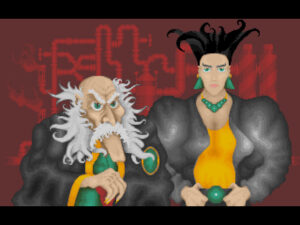It turns out that it’s possible to finish most of the main quests in Avalon before the detour through Fairyland. I just happened to solve the puzzles that led to getting stuck in Fairyland before doing much of anything else, and this skewed my perception of the story. I could have purified the grail first thing, if I’d had more patience. I could have awakened Merlin first, and gotten answers a lot earlier about what was going on, what I was supposed to be doing and why. That might have grounded my adventures more.
Or maybe not. The truth is frankly bizarre: to save the world from the doom you’ve foreseen, you have to accompany Merlin to present-day Stonehenge to tap into its magic, so he can cast a spell to send you back in time to exorcise and slay the demon possessing Lee Harvey Oswald before he assassinates Kennedy. I guess this means real life is still on the bad timeline. There’s some suggestion that Frank is, too: the ending hints that even in the midst of your hard-earned happily-ever-after, your travails aren’t over.
Or at least, the ending I got does so. Apparently there are multiple endings, depending on what decisions you made and which optional puzzles you solved along the way. I don’t think there’s a great deal of variability in Fairyland, but in Avalon, there was an entire puzzle sequence about slaying a dragon that I simply never solved. Consulting a walkthrough afterward, I find it has to do with Excalibur’s ability to summon spirits the dead. Not a power I recall seeing elsewhere in Arthurian literature, but I did see it mentioned in this game by multiple sources, so I knew it was possible. Nonetheless, no matter who I tried to summon, it simply failed. It turns out that the only summonable spirits are Launcelot and Galahad, and Merlin would have told me this if I had asked him about the right topic. I can’t be too upset about this, though, because you can win the game perfectly well without them.
But I’m not inclined to pursue the other endings and see if they’re better, because that would require redoing the entire Stonehenge sequence, which is the single most tedious part of the game. Stonehenge is represented as a grid of rooms, with individual stones and trilithons implemented as objects, and you’re expected to examine them individually to find the marks Merlin needs for his spell. There’s a modicum of interesting commentary in the rock descriptions, but I suspect that the gameplay here was invented to justify the effort that went into the implementation, rather than to serve the player experience. I suppose it wouldn’t be so bad the second time around, though, when you know where everything is. That’s one of the nice things about text adventures: the ease with which you can breeze through the familiar parts. I just gripe because I’m playing from the perspective of the year 2021, where wasting the player’s time and attention is less easily forgiven than it was in 1998.
Meanwhile, the Dallas section uses the division of space into more rooms than necessary in a way that I thought fit the story quite neatly. You’re on a race against time to reach the book depository before it’s too late, so of course this requires more steps than you want it to. That’s exactly what it would feel like.
Anyway, even from a 2021 perspective, I did enjoy this game overall. I just enjoyed it more in the Fairyland section, where the puzzles are stronger and the story is more stylized. The whole story is built around an incongruous juxtaposition, but the end notes indicate that the author was more interested in using Frank Leandro to talk about King Arthur than in using King Arthur to talk about Frank Leandro, and it shows.
 Comments(0)
Comments(0)